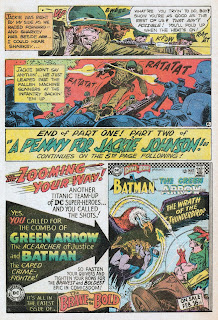|
|
|
|
|
Feb 4, 2011
Social History in Comics: Our Army At War 179 - "A Penny for Jackie Johnson!"
This Kanigher/Kubert Jackie Johnson story in the April 1966 issue of Our Army At War (179) is reminiscent of the Lee/Kirby story in Sgt. Fury 6 of a few years earlier. One of Bob Kanigher's specialties was the writing of anti-racist comics, and many of the few 1960s comics to address this issue were by him. The tension between the tolerant Johnson and the bigoted Sharkey, who, from the moment he joins Easy, harasses the African American soldier, recalls the sparring between Gabriel Jones and George Stonewell in Sgt. Fury 6. Sharkey represents a stereotype of sorts himself - he identifies himself as from the mountains, suggesting a fairly remote white community hanging onto antebellum racist values. Sharkey also voices a stereotypically negative opinion of the reliability of African American fighters/soldiers. Although set in WWII, in which there were few instances when white and black soldiers fought side by side, the anti-racist messages in both the Sgt. Rock and Sgt. Fury stories appear aimed at combating the racial tension that at the time was tearing apart the U.S. military, especially in Vietnam, as well as civilian society.
The plot revolves around the penny Sharkey placed in Jackie's hand when he offered it to him when they first met. Throughout Jackie leaves the door open for Sharkey to drop his racist stance, but Sharkey ain't bitin'. Finally, in extremely dangerous circumstances, Sharkey and Jackie are both wounded, and Jackie risks his life to rescue Sharkey and get him back to camp. At last Sharkey breaks, and experiences a life-changing revision of consciousness. Rock, as usual the story's narrator, ends by reminding the reader of what he said at the beginning, that in Easy there's only one skin color, and that's G.I.!
Kanigher's message here is simple. It's in our best interests as Americans to see each other that way, as Americans and not as separate categories of people based on race and skin color, even though those morphological and even cultural differences might be there. I'd say that on one level Kanigher seems to promote the 'melting pot' approach to integration, because Easy, as American society in microcosm, is the uniting principle that over-rides and even obliterates any differences amongst its members. On the other hand there is also recognition of racial differences within that unification, exemplified by Rock's comment that Jackie is always fighting his own war to gain acceptance of his race. That could be extended into a philosophy that promotes acceptance of diversity within the over-arching unity. Jackie is not expected to nullify his African American identity. Each member of Easy is expected to accept the others without qualification, regardless of racial or ethnic difference. That is the usual, unspoken (because it isn't necessary normally to bring up the issue) status quo of Easy, disrupted in this story by the incoming presence of a racist whose divisive view of humanity clashes with Easy's harmony. This story does place the responsibility for racist attitudes with a white American, but the reality in the U.S. military was that, increasingly as Vietnam wore on especially, racial tension or actual violence within the forces was as much instigated by African Americans as it was by whites. This is a trickier issue to address, because historically it had been clear that the white American, as the oppressor, was at least the only force capable of open expression of racism. Racist African Americans were of course in existence but somehow excused for their racism because, as Malcolm X pointed out, such was a natural response to the racist oppression African Americans had been subjected to. However, while it might be understandable in terms of causality, racism of all descriptions causes division and is destructive. Both Marvel and DC did attempt to address anti-white racism, appropriately far less frequently than they looked at racism against African Americans, and it is definitely an even more sensitive issue. It's also important to remember that we're talking about very, very few comic books that dared to tackle the issues of racism and integration in the 1960s. A fraction of a fraction of a fraction of 1% of the total number of comics produced during the decade. Those books that do address it tend to be well-written, and by authors whose purpose appears to be to make a statement, not just to gain sales by appealing to the African American audience. Maybe the company allowed it because they thought, as an idea, that it would sell, but nobody writes this kind of material to this standard without some deep personal conviction, especially when society was still divided on the issue- it comes across on the page. Kanigher was a big writer and editor, who didn't blow his own trumpet, so you don't hear him mentioned as much as others who did as much or less work than he did for comics. But the more you study his anti-racist comics, and realize just how rare it was to write such material in mainstream comics back then, the more I think you'll recognize that Bob Kanigher was not only a pioneer in this area, but a man of strong and well-considered principles, who abhorred racism and actively sought to do what he could, through his work, to combat the harm it does to so many people, both perpetrators and victims, as well as to our society as a whole.
Posted by
rm4d4n1
Labels:
African American characters,
Bob Kanigher,
Jackie Johnson,
Joe Kubert,
Our Army At War,
Racial Integration,
Sgt. Rock,
World War II

























